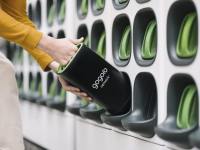Global engineering giant AECOM is to partner with British airship developer Hybrid Air Vehicles (HAV) to provide infrastructure services for HAV’s Airlander hybrid aircraft – a helium airship with auxiliary wing and tail surfaces.
The Airlander flies using both aerostatic and aerodynamic lift and HAV estimates the CO2 footprint per passenger on its Airlander 10 will be about 4.5kg, compared with about 53kg per passenger on a jet plane.
The partnership will draw on AECOM’s consulting and advisory services for cost and carbon benchmarking, sustainability development, master planning, construction program management and scheme delivery. The work will include advice on hydrogen supply infrastructure and transit interchange design.
“We are excited to work with Hybrid Air Vehicles to develop infrastructure which will enable the transition to net zero aviation,” says Colin Wood, AECOM’s chief executive of Europe and India. “Just a few months ago, speakers at COP26 called on industry to develop the solutions so desperately needed to limit global warming. Whilst there is no room for complacency, I’m proud of the work AECOM is doing to tackle this challenge head on by taking bold steps to advance new and emerging sectors which will help us achieve net zero.”
“The relationship between AECOM and Hybrid Air Vehicles is centred in our shared commitment to delivering net zero,” adds Tom Grundy, Hybrid Air Vehicles’ chief executive officer. “We urgently need to reduce emissions in aviation, so we will work with AECOM and Airlander operators to make zero emission flight for 100 passengers or ten tons of cargo a reality within the decade.”
The partnership sees AECOM and Hybrid Air Vehicles sign a memorandum of understanding which sets out the basis and scope of a long-term infrastructure partnership. AECOM will provide end-to-end infrastructure partner services to facilitate the operation of the aircraft, which will deliver 90% fewer emissions than other aircraft when it enters service in 2026 and will run entirely on hydrogen by 2030 through fuel cell technology.
HAV and AECOM will work together with HAV’s customers to develop the infrastructure to operate Airlander, including preparing for hydrogen on site for the hybrid-electric and all-electric Airlander 10 aircraft. In addition, AECOM will work with HAV to develop the Airlander 10 manufacturing facility. Additional joint work on the larger Airlander 50 and other projects is expected.





